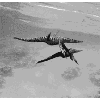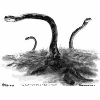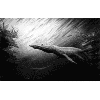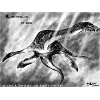SAUROPTERYGIA
CLASSIFICATION
Animalia: Vertebrata: Tetrapoda: Sauropsida
CLADOGRAM:
—Sauropterygia “lizard fins”
|–Placodontia (“reptilian walruses”)
| |–Helveticosauridae
| `–Placodontoidea
| |–Chelyoposuchus
| |–Cyamodontidae
| |–Henodontidae
| `–Placodontidae
`–+?-Claudiosauridae
`–Eusauropterygia “true sauropterygians”
|–Corosaurus
|–Simosaurus
|–Nothosauridae
|–Pachypleurosauridae
`–+–Cymatosaurus
`–+–Pistosaurus
`–Plesiosauria “Plesiosaurus‘ taxon”
|–Pliosauridae
`–Plesiosauroidea
|–Plesiosauridae
`–+–Cryptoclididae
`–+–Elasmosauridae
`–Polycotylidae
ESSAY
| Sauropterygians were a group of marine reptiles of uncertain origin. At times allied to turtles or prolacertiforms, they are probably diapsids, possibly a basal lineage of either Lepidosauromorpha or Archosauromorpha. C HARACTERISTICS AND NICHES:Their limbs had evolved into flippers, which they used to swim through the Mesozoic seas. The advanced sauropterygians, plesiosaurs, came in two main body forms. Pliosaurs had long, large heads, and short necks, similar to the distantly related mosasaurs. Plesiosauroids had extremely long necks with tiny heads, looking something like a cross between a sea turtle and a snake. All sauropterygians were carnivorous. Placodonts may or may not have been sauropterygians. They were large, probably sluggish creatures somewhat similar in form to today’s walruses and sirenians (manatees and dugongs). Their broad teeth splayed outward from their mouths. It has been suggested that they used them to crush mollusk shells. T HE END:Sauropterygians died out at the end of the Cretaceous, along with all non-neornithean dinosaurs. There have been reports of modern-day populations of plesiosauroids, but these have either turned out to be other animals (rotting basking shark carcasses) or deliberate hoaxes (the Loch Ness monster). |
IMAGES
| A pliosaur (Leptocleidus clemai) sneaks up on a fish (Squatina) on the Australian ocean floor. (Carcharias swims in the background.) |
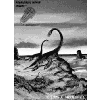
Two adult Plesiosaurus brachypterygius rest upon a Jurassic beach as their brood hatches. |
